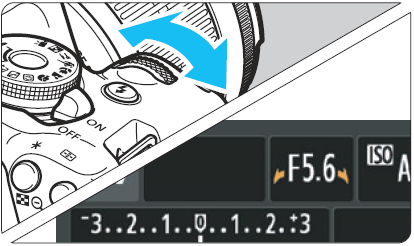To blur the background or to make everything near and far look sharp, set the Mode Dial to
<Av> (Aperture-priority AE) to adjust the depth of field (range of acceptable focus).
* <Av> stands for Aperture value, which is the size of the diaphragm hole inside the lens.

 |
Set the Mode Dial to <Av>. |
 |
Set the desired aperture.
- The higher the f/number, the wider the depth of field where sharper focus is obtained in both the foreground and background.
- Turning the <6> dial to the right will set a higher f/number (smaller aperture opening), and turning it to the left will set a lower f/number (larger aperture opening).
|
 |
Take the picture.
- Focus and press the shutter button completely. The picture will be taken with the selected aperture.
|
Aperture Display
The higher the f/number, the smaller the aperture opening will be. The f/number displayed will differ depending on the lens. If no lens is attached to the camera,
“00” will be displayed for the aperture
Shooting Tips
- When using an aperture with a high f/number or shooting in low light scenes, note that camera shake can occur. A higher aperture f/number will make the shutter speed slower. Under low light, the shutter speed can be as long as 30 sec. In such cases, increase the ISO speed and hold the camera steady or use a tripod.
- The depth of field depends not only on the aperture, but also on the lens and on the subject distance. Since wide-angle lenses have a wide depth of field (range of acceptable focus in front of and behind the point of focus), you need not set a high aperture f/number to obtain a sharp picture from the foreground to the background. On the other hand, a telephoto lens has a narrow depth of field. And the closer the subject, the narrower the depth of field. A farther subject will have a wider depth of field.
- Set the aperture so that the shutter speed display does not blink. If you press the shutter button halfway and change the aperture while the shutter speed is displayed, the shutter speed display will also change to maintain the same exposure (amount of light reaching the image sensor). If you exceed the adjustable shutter speed range, the shutter speed display will blink to indicate that the standard exposure cannot be obtained. If the picture will be too dark, the “30"” (30 sec.) shutter speed display will blink. If this happens, turn the
 dial to the left to set a lower f/number or increase the ISO speed. If the picture will be too bright, the “4000” (1/4000 sec.) shutter speed display will blink. If this appens, turn the
dial to the left to set a lower f/number or increase the ISO speed. If the picture will be too bright, the “4000” (1/4000 sec.) shutter speed display will blink. If this appens, turn the  dial to the right to set a higher f/number or decrease the ISO speed
dial to the right to set a higher f/number or decrease the ISO speed
Using the Built-in Flash
To obtain a correct flash exposure, the flash output will be set automatically to match the set aperture (autoflash). The shutter speed will be set automatically between 1/200 sec. - 30 sec. to suit the scene’s brightness. In low light, the main subject is exposed with the autoflash, and the background is exposed with a slow shutter speed set automatically. Both the subject and background look properly exposed with a touch of atmosphere (automatic slow-speed flash sync). If you are handholding
the camera, keep it steady to prevent camera shake. Using a tripod is recommended.
To prevent a slow shutter speed, under [53: Custom Functions (C.Fn)], set [3: Flash sync. speed in Av mode] to [1: 1/200-1/60sec. auto] or [2: 1/200sec. (fixed)] (p.261).